steps for transforming dream to reality

1. The first meeting
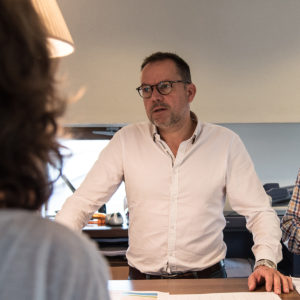
For listening, feeling, exchanging, understanding, and setting course.
The first meeting results in a definition of a specification. This is Pierre-François Amevet’s job and his alone!
It’s a completely open discussion. The objective is to analyse wishes, understand lifestyles, and deliver a vision that encompasses the whole project, without ever trying to hide potential snags.
“I start by listening, then I listen some more to be absolutely certain of understanding and making myself understood. Then I reformulate, I relate, I explain, I reassure, I nurture the dream. In two hours, I convey all the essentials to my client: the atmosphere, the timing, the budget, how we operate.”
This first step is the embodiment of Agence Amevet’s know-how.

2. Scenarios
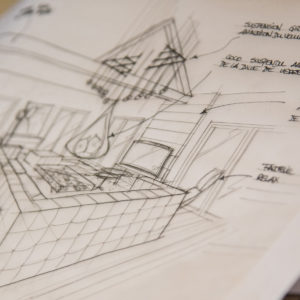
For imagining, creating, and setting the stage with custom proposals.
The first meeting provides the body and core of the methodology that is about to click into gear: “At this stage, I gather matter with which I can inspire my interior architects. I already have a good idea of my dream team in my head.”
But let’s not get ahead of ourselves. The vision is still abstract and must be turned into sketches and plans. The interior architects map out the flows and general functioning of the various spaces. They imagine unique concepts in terms of ambience, style, equipment, furniture, even down to client services for professionals.
The budget and schedule start to take firm shape.

3. Design
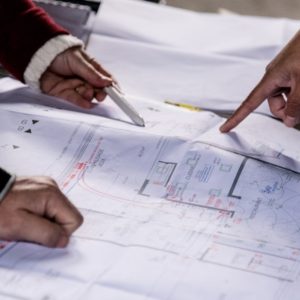
For translating and concretizing.
Sketches become drawings. The plans reach all the way down to minute technical details. Materials and equipment are chosen.
This is the moment when drawing offices can be called on to input their specialist expertise in structures, fluids, acoustics, and other technical issues. Administrative procedures are opened for planning permission, prior declarations and such. Nothing is left to chance!
Trades are identified, craft contractors chosen, now it’s time to plan job execution management.

4. Execution

For coordinating, managing and materializing the dream.
Managing job execution means taking an active leadership role as well as holding regular meetings with the client. And of course making sure there are no budget or schedule overruns.
Because the second-fix trades hide no further secrets from him, because he knows regulations and procedures like the back of his hand, because he and his team have in-depth technical expertise in structures and materials, because oddball demands stimulate him—for all these reasons, and because he never neglects the overall consistency of a project even under pressure, Pierre-François Amevet makes the oversight of each job a personal challenge!
TRADES
Trades at the service of methodology

Interior architect

Coordinator

Job execution manager

Furnishing designer

Graphic
Designer
 Interior architect
Interior architect
The interior architect sees the architecture through to its completion, in rational and creative detail, juggling with space, light, colour, furniture, equipment, objects and the occupant’s own quirks in order to create places that are not only practical and comfortable but also reflect the order giver’s personality.
Interior architects are master builders, creators, designers of private and business spaces. Although they can be involved in newbuild projects, they are most often called on for renovation, transformation, extension of existing interior spaces. If the main evidence of an interior architect’s work is the look and feel of their creations, behind the scenes they are technicians, space designers, who must adhere to very exacting codes.
When Agence Amevet’s interior architects develop a project, they create a place for living where a story will be written. Whether they lean more to the technical side or to the decoration side, they all buy into the idea that an accomplished project is always the fruit of an alchemy based on listening, communication, creativity, counselling, and technical expertise.
Coordinator
Every project is like a film with a large cast—starring the client! Clients have dreams, wishes, needs. They instil their vision in the mind of the interior architect, this actor, this builder of bespoke spaces who interprets it into plans, perspectives, colour codes, material samples. Before and during the project, the cast swells with the entry on scene of drawing offices, contractors, and craft contractors. Not forgetting supporting roles like the administrative services and the many and varied suppliers.
For the film to succeed, all this needs synchronizing, and that’s the coordinator’s role. Their role is essential and comprises a multitude of operational tasks: answering e-mails and phone calls, asking for quotations, penning reports, discharging interior architects from administrative paperwork, travelling from site to office and office to site, etc.
Their mission: to enable everyone involved to concentrate on their core trade. It’s a full time job requiring panoramic vision, top-class technical skills, a heightened sense of organization, and an outstanding memory!
 JOB EXECUTION MANAGER
JOB EXECUTION MANAGER
Job execution management, or directing of works if you prefer, is a real strength of Agence Amevet.
All through the project, the director and lead interior architect Pierre-François Amevet remains the key intermediary for all parties. No matter how many or how big the projects are, no matter how they overlap in time, he stays in constant touch with his client, his team, and his craft contractors. He’s the one with ultimate responsibility. He’s the one who physically and morally undertakes to succeed, delivering a final result identical in every respect to the promise made to the client.
Project meetings are held with metronome-like regularity. Milestones and budgets are adhered to. The jobs are positive adventures, free from harmful stress.
Furnishing designer
Furnishing design is not that far away from decoration.
Once the interior architects have defined the setting and ambiences and finalized the resulting technical choices, there remains the issue of choosing furniture and accessories. The furnishing designer therefore goes to work on the task of optimizing the harmonies decided on by the interior architects. They proceed all the way to the final choice, selecting furniture, materials, objects, and the rest.
 Graphic designer
Graphic designer
Agence Amevet brings graphic design trades on board in order to offer a “360°” mode to clients who want the project to extend to external communication.
Here we are talking mostly about facade signs, logos, general signage, pictograms, specific decorations requiring image searches, etc. This work is mainly of interest to the business sphere: concept stores, shop-remodelling, hotels, restaurants, etc. In all these cases, Agence Amevet can offer a complete service!


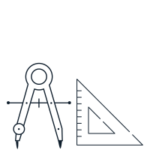 Interior architect
Interior architect
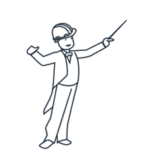

 Graphic designer
Graphic designer